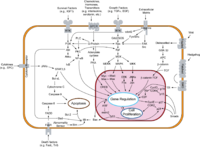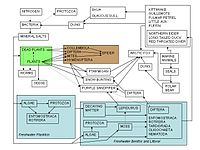- Modelling biological systems
-
Modeling biological systems is a significant task of systems biology and mathematical biology. Computational systems biology aims to develop and use efficient algorithms, data structures, visualization and communication tools with the goal of computer modeling of biological systems. It involves the use of computer simulations of biological systems, like cellular subsystems (such as the networks of metabolites and enzymes which comprise metabolism, signal transduction pathways and gene regulatory networks) to both analyze and visualize the complex connections of these cellular processes.
Artificial life or virtual evolution attempts to understand evolutionary processes via the computer simulation of simple (artificial) life forms.
Contents
Overview
It is understood that an unexpected emergent property of a complex system is a result of the interplay of the cause-and-effect among simpler, integrated parts (see biological organisation). Biological systems manifest many important examples of emergent properties in the complex interplay of components. Traditional study of biological systems requires reductive methods in which quantities of data are gathered by category, such as concentration over time in response to a certain stimulus. Computers are critical to analysis and modeling of these data. The goal is to create accurate real-time models of a system's response to environmental and internal stimuli, such as a model of a cancer cell in order to find weaknesses in its signaling pathways, or modeling of ion channel mutations to see effects on cardiomyocytes and in turn, the function of a beating heart.
A monograph on this topic summarizes an extensive amount of published research in this area up to 1987,[1] including subsections in the following areas: computer modeling in biology and medicine, arterial system models, neuron models, biochemical and oscillation networks, quantum automata, quantum computers in molecular biology and genetics, cancer modeling, neural nets, genetic networks, abstract relational biology, metabolic-replication systems, category theory[2] applications in biology and medicine,[3] automata theory, cellular automata, tessallation models[4][5] and complete self-reproduction, chaotic systems in organisms, relational biology and organismic theories.[6][7] This published report also includes 390 references to peer-reviewed articles by a large number of authors.[8][9][10]
Standards
By far the most widely accepted standard format for storing and exchanging models in the field is the Systems Biology Markup Language (SBML)[11] The SBML.org website includes a guide to many important software packages used in computational systems biology. Other markup languages with different emphases include BioPAX and CellML.
Particular tasks
Cellular model
A sample time-series of the Lotka-Volterra model. Note that the two populations exhibit cyclic behaviour.
Creating a cellular model has been a particularly challenging task of systems biology and mathematical biology. It involves the use of computer simulations of the many cellular subsystems such as the networks of metabolites and enzymes which comprise metabolism, signal transduction pathways and gene regulatory networks to both analyze and visualize the complex connections of these cellular processes.
The complex network of biochemical reaction/transport processes and their spatial organization make the development of a predictive model of a living cell a grand challenge for the 21st century.
In 2006, the National Science Foundation (NSF) put forward a grand challenge for systems biology in the 21st century to build a mathematical model of the whole cell.[12] E-Cell Project aims "to make precise whole cell simulation at the molecular level possible".[13] CytoSolve developed by V. A. Shiva Ayyadurai and C. Forbes Dewey, Jr. of Department of Biological Engineering at the Massachusetts Institute of Technology, provided a method to model the whole cell by dynamically integrating multiple molecular pathway models.[14][15]
Membrane computing is the task of modeling specifically a cell membrane.
Protein folding
Main article: Protein folding problemProtein structure prediction is the prediction of the three-dimensional structure of a protein from its amino acid sequence—that is, the prediction of a protein's tertiary structure from its primary structure. It is one of the most important goals pursued by bioinformatics and theoretical chemistry. Protein structure prediction is of high importance in medicine (for example, in drug design) and biotechnology (for example, in the design of novel enzymes). Every two years, the performance of current methods is assessed in the CASP experiment.
Human biological systems
Brain model
The Blue Brain Project is an attempt to create a synthetic brain by reverse-engineering the mammalian brain down to the molecular level. The aim of the project, founded in May 2005 by the Brain and Mind Institute of the École Polytechnique in Lausanne, Switzerland, is to study the brain's architectural and functional principles. The project is headed by the Institute's director, Henry Markram. Using a Blue Gene supercomputer running Michael Hines's NEURON software, the simulation does not consist simply of an artificial neural network, but involves a partially biologically realistic model of neurons.[16][17] It is hoped by its proponents that it will eventually shed light on the nature of consciousness. There are a number of sub-projects, including the Cajal Blue Brain, coordinated by the Supercomputing and Visualization Center of Madrid (CeSViMa), and others run by universities and independent laboratories in the UK, U.S., and Israel.
Model of the immune system
The last decade has seen the emergence of a growing number of simulations of the immune system.[18][19]
Tree model
Electronic trees (e-trees) usually use L-systems to simulate growth. L-systems are very important in the field of complexity science and A-life. A universally accepted system for describing changes in plant morphology at the cellular or modular level has yet to be devised.[20] The most widely implemented tree generating algorithms are described in the papers "Creation and Rendering of Realistic Trees", and Real-Time Tree Rendering
Ecological models
Ecosystem models are mathematical representations of ecosystems. Typically they simplify complex foodwebs down to their major components or trophic levels, and quantify these as either numbers of organisms, biomass or the inventory/concentration of some pertinent chemical element (for instance, carbon or a nutrient species such as nitrogen or phosphorus).
Modeling of infectious disease
It is possible to model the progress of most infectious diseases mathematically to discover the likely outcome of an epidemic or to help manage them by vaccination. This field tries to find parameters for various infectious diseases and to use those parameters to make useful calculations about the effects of a mass vaccination programme.
See also
- Biological data visualization
- Molecular modeling software
- Stochastic simulation
- Gillespie algorithm
Notes
- ^ http://en.scientificcommons.org/1857371
- ^ http://planetphysics.org/encyclopedia/BibliographyForCategoryTheoryAndAlgebraicTopologyApplicationsInTheoreticalPhysics.html
- ^ http://planetphysics.org/encyclopedia/BibliographyForMathematicalBiophysicsAndMathematicalMedicine.html
- ^ Modern Cellular Automata by Kendall Preston and M. J. B. Duff http://books.google.co.uk/books?id=l0_0q_e-u_UC&dq=cellular+automata+and+tessalation&pg=PP1&ots=ciXYCF3AYm&source=citation&sig=CtaUDhisM7MalS7rZfXvp689y-8&hl=en&sa=X&oi=book_result&resnum=12&ct=result
- ^ http://mathworld.wolfram.com/DualTessellation.html
- ^ Baianu, I. C. 1987, Computer Models and Automata Theory in Biology and Medicine., in M. Witten (ed.),Mathematical Models in Medicine, vol. 7., Ch.11 Pergamon Press, New York, 1513-1577. http://cogprints.org/3687/
- ^ http://www.kli.ac.at/theorylab/EditedVol/W/WittenM1987a.html
- ^ http://www.springerlink.com/content/w2733h7280521632/
- ^ Currently available for download as an updated PDF: http://cogprints.ecs.soton.ac.uk/archive/00003718/01/COMPUTER_SIMULATIONCOMPUTABILITYBIOSYSTEMSrefnew.pdf
- ^ http://planetphysics.org/encyclopedia/BibliographyForMathematicalBiophysics.html
- ^ Klipp, Liebermeister, Helbig, Kowald and Schaber. (2007). "Systems biology standards—the community speaks" (2007), Nature Biotechnology 25(4):390–391.
- ^ American Association for the Advancement of Science [1]
- ^ http://www.e-cell.org/ecell/
- ^ National Center for Biotechnology Information [2. http://www.ncbi.nlm.nih.gov/pmc/articles/PMC3032229/]
- ^ Massachusetts Institute of Technology [2]
- ^ Graham-Rowe, Duncan. "Mission to build a simulated brain begins", NewScientist, June 2005.
- ^ Palmer, Jason. Simulated brain closer to thought, BBC News.
- ^ [3]
- ^ "Computer Simulation Captures Immune Response To Flu". http://www.sciencedaily.com/releases/2009/05/090518111729.htm. Retrieved 2009-08-19.
- ^ "Simulating plant growth". http://www.acm.org/crossroads/xrds8-2/plantsim.html. Retrieved 2009-10-18.
References
-
- Barab, A. -L.; Oltvai, Z. (2004). "Network biology: understanding the cell's functional organization". Nature reviews. Genetics 5 (2): 101–113. doi:10.1038/nrg1272. PMID 14735121.
- Covert; Schilling, C.; Palsson, B. (2001). "Regulation of gene expression in flux balance models of metabolism". Journal of theoretical biology 213 (1): 73–88. doi:10.1006/jtbi.2001.2405. PMID 11708855.
- Covert, M. W.; Palsson, B. . (2002). "Transcriptional regulation in constraints-based metabolic models of Escherichia coli". The Journal of biological chemistry 277 (31): 28058–28064. doi:10.1074/jbc.M201691200. PMID 12006566.
- Edwards; Palsson, B. (2000). "The Escherichia coli MG1655 in silico metabolic genotype: its definition, characteristics, and capabilities". Proceedings of the National Academy of Sciences of the United States of America 97 (10): 5528–5533. Bibcode 2000PNAS...97.5528E. doi:10.1073/pnas.97.10.5528. PMC 25862. PMID 10805808. http://www.pubmedcentral.nih.gov/articlerender.fcgi?tool=pmcentrez&artid=25862.
- Bonneau, R. (2008). "Learning biological networks: from modules to dynamics". Nature chemical biology 4 (11): 658–664. doi:10.1038/nchembio.122. PMID 18936750.
- Edwards, J. S.; Ibarra, R. U.; Palsson, B. O. (2001). "In silico predictions of Escherichia coli metabolic capabilities are consistent with experimental data". Nature biotechnology 19 (2): 125–130. doi:10.1038/84379. PMID 11175725.
- Fell, D. A. (1998). "Increasing the flux in metabolic pathways: A metabolic control analysis perspective". Biotechnology and Bioengineering 58 (2–3): 121–124. doi:10.1002/(SICI)1097-0290(19980420)58:2/3<121::AID-BIT2>3.0.CO;2-N. PMID 10191380.
- Hartwell, L. H.; Hopfield, J. J.; Leibler, S.; Murray, A. W. (1999). "From molecular to modular cell biology". Nature 402 (6761 Suppl): C47–C52. doi:10.1038/35011540. PMID 10591225.
- Ideker; Galitski, T.; Hood, L. (2001). "A new approach to decoding life: systems biology". Annual review of genomics and human genetics 2 (1): 343–372. doi:10.1146/annurev.genom.2.1.343. PMID 11701654.
- Kitano, H. (2002). "Computational systems biology". Nature 420 (6912): 206–210. Bibcode 2002Natur.420..206K. doi:10.1038/nature01254. PMID 12432404.
- Kitano, H. (2002). "Systems biology: a brief overview". Science 295 (5560): 1662–1664. Bibcode 2002Sci...295.1662K. doi:10.1126/science.1069492. PMID 11872829.
- Kitano (2002). "Looking beyond the details: a rise in system-oriented approaches in genetics and molecular biology". Current genetics 41 (1): 1–10. doi:10.1007/s00294-002-0285-z. PMID 12073094.
- Gilman, A. G.; Simon, M. I.; Bourne, H. R.; Harris, B. A.; Long, R.; Ross, E. M.; Stull, J. T.; Taussig, R. et al. (2002). "Overview of the Alliance for Cellular Signaling". Nature 420 (6916): 703–706. doi:10.1038/nature01304. PMID 12478301.
- Palsson, Bernhard (2006). Systems biology: properties of reconstructed networks. Cambridge: Cambridge University Press. ISBN 978-0-521-85903-5.
- Kauffman; Prakash, P.; Edwards, J. S. (2003). "Advances in flux balance analysis". Current opinion in biotechnology 14 (5): 491–496. doi:10.1016/j.copbio.2003.08.001. PMID 14580578.
- Segrè, D.; Vitkup, D.; Church, G. M. (2002). "Analysis of optimality in natural and perturbed metabolic networks". Proceedings of the National Academy of Sciences of the United States of America 99 (23): 15112–15117. Bibcode 2002PNAS...9915112S. doi:10.1073/pnas.232349399. PMC 137552. PMID 12415116. http://www.pubmedcentral.nih.gov/articlerender.fcgi?tool=pmcentrez&artid=137552.
- Wildermuth, MC (2000). "Metabolic control analysis: biological applications and insights.". Genome biology 1 (6): REVIEWS1031. PMC 138895. PMID 11178271. http://www.pubmedcentral.nih.gov/articlerender.fcgi?tool=pmcentrez&artid=138895.
Further reading
- Antmann, S. S.; Marsden, J. E.; Sirovich, L., eds (2009). Mathematical Physiology (2nd ed.). New York, New York: Springer. ISBN 9780387758466.
- Barnes, D.J.; Chu, D. (2010), Introduction to Modelling for Biosciences, Springer Verlag, http://www.cs.kent.ac.uk/projects/imb/
External links
Scientific modelling Biological Biological data visualization · Chemical process modeling · Cellular model · Protein structure prediction · Ecosystem model · Infectious disease model · Metabolic network modellingEnvironmental Atmospheric model · Wildfire modeling · Chemical transport model · Modular Ocean Model · Climate model · Hydrological modelling · Hydrological transport model · Groundwater model · Geologic modellingSocial Crime mapping · Population modeling · Biopsychosocial model · Economic model · Input-output model · Business process modelling · Construction and management simulation · Catastrophe modelingRelated topics Systems thinking · Mathematical modeling · Model theory · Systems theory · Visual analytics · Data visualization · List of computer simulation softwareCategories:- Bioinformatics
- Systems biology
- Scientific modeling
Wikimedia Foundation. 2010.



